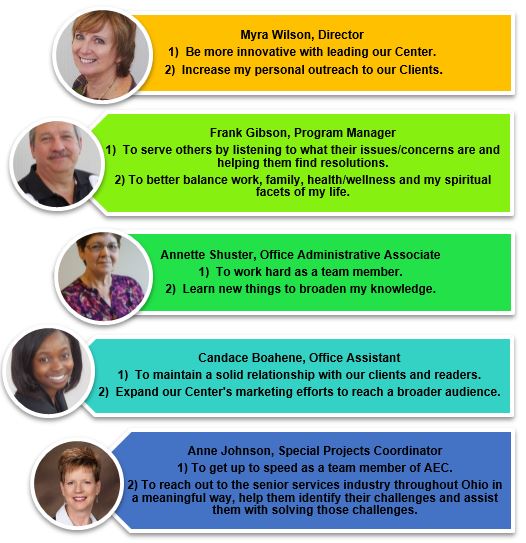
(from left) Anne Johnson, Program Manager, Kathryn Brod, President & CEO of LeadingAge Ohio (award recipient), Myra Wilson, Program Director of Alber Enterprise Center (AEC) presented Brod with the Outstanding Achievement and Excellence Award for Collaboration in Framing the Future of Long-Term Care Services. Brod accepted the award for her leadership and continued efforts in assisting AEC and the LTSS consortium with an in-depth look in implementing solutions for the long-term care industry.
Four Ohio organizations and a Michigan consultant were recently honored for their outstanding impact in leadership by The Ohio State University’s Alber Enterprise Center.
The honorees were: LeadingAge Ohio of Columbus, National Church Residences of Columbus, Uni-Grip, Inc, of Upper Sandusky, Cowen Truck Line, Inc. of Perrysville, and Performance Innovation, LLC of Novi, MI.
Each organization has partnered with the Alber Enterprise Center (AEC) to examine organizational challenges in their respective industries, streamline processes to enhance work flow, and/or receive executive training customized to suit their company needs.
LeadingAge Ohio, Columbus, received the Outstanding Achievement and Excellence Award for Collaboration in Framing the Future of Long-Term Care Services. LeadingAge Ohio’s outstanding leadership over the course of the past year helped AEC make significant in-roads in identifying organizational challenges in long term services and support. President & CEO of LeadingAge Ohio, Columbus, Kathryn Brod accepted the award. Kathryn actively participated in AEC’s Long-Term Services & Supports (LTSS) Consortium and subsequently brought the activities of the consortium under the wing of the HR committee of the LeadingAge Ohio Board of Directors. These continued efforts will assist AEC and the consortium to take an in-depth look in developing solutions that will make an impact for years to come. In addition, Brod is a champion in maintaining the partnership between both organizations in moving forward and making an impact on front-line supervisors through their Leadership Challenge® workshops.
National Church Residences, Columbus, received Outstanding Achievement and Excellence Award for Collaboration in Framing the Future of Long-Term Care Services. National Church Residences’ participation in AEC’s LTSS consortium and their efforts in implementing solutions to revitalize the long-term services and supports for elder care will impact this industry over the course of time. Moreover, some of the staff’s involvement in AEC’s The BRIDGE facilitator training refined their facilitation process.
Uni-Grip, Inc., Upper Sandusky, received the Investment in Quality Management Systems award. Uni-Grip’s financial investment in their quality systems and action steps to track measurements of key performance indicators led to their growth. Within eight months of intense focus on change, a few of Uni-Grip’s impacts were: reduction in weekly scrap, increase in yearly sales, reduction of past due orders and improvements in staff’s knowledge and awareness in all of these areas.
Cowen Truck Line, Inc., Perrysville, received Outstanding Achievement and Excellence Award for Positive Impact on Business from The BRIDGE: Issue Management Process. Cowen’s successful utilization of AEC’s BRIDGE Process created the foundation that resulted in crafting a plan to take their organization into the next 40 years to serve their customers. A few areas that have been impacted include: hired new drivers, increased sales in 2015, and enhanced communication with drivers.
Performance Innovation, LLC, Novi, MI received the Outstanding Educational Partner Award for Excellence in Service to the Voice of the Customer. The outstanding leadership and customer service Performance Innovation, LLC displayed over time helped AEC make an impact with their clientele. President of Performance Innovation, LLC, Norma Simons accepted the award. As one of AEC’s most valued educational partners, Simons exhibits great comprehension of Lean Six Sigma and skillfully communicates its complexity in a manner that is clearly understood by her class participants. In addition, Simons’ responsiveness to clients’ needs and flexibility in how her services are delivered whether it is online, face-to-face or a blended approach has shown proven results.
AEC’s Client Advisory Council half-day meeting concluded with the Awards Luncheon. The meeting objectives for council members were to provide feedback on AEC’s past services, input on how the Center can support the business priorities of clients, offer suggestions about new services AEC could provide and ideas for strategic direction.
The Alber Enterprise Center applies the resources of The Ohio State University, OSU Extension, along with a team of organization development consultants to enable Ohio businesses to positively impact economic growth. For more information, call 740-725-6325 or visit alber.osu.edu.





